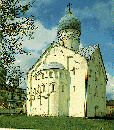The Church of Transfiguration of Our Saviour in Eliyah Street
 One of Novgorod's most celebrated monuments is the Church of Transfiguration of Our Saviour in Eliyah Street (1374). Both in its architectural aspect and in its constructive techniques, the building has much in common with earlier and contemporaneous structures. Among the later additions is the eight-slope roof which replaced the three-pitched one in the 16th century. Characteristic of 14th- and 15th-century architecture, the latter echoed the overall construction of the building. Whereas the pilasters articulating the double-stepped form of the walls occur, though rarely, in Novgorodian architecture, the decoration of the facades sharply differs from the typically Novgorodian restrained decor. Executed with surprising freedom and ease, it features seemingly at random scattered windows, variously shaped niches and numerous crosses which, taken together, produce the sensation of a free equilibrium. At the same time, the tooth-edged bricks accentuate the expressiveness of the multi-slo pe roof. The facades are decorated differently, depending on their importance. Especially lavish is the decor of the main, southern facade. In its regular pattern and strict symmetry the decoration of the drum seems to embody the calm unchangeability of the heavenly as contrasted to the transience of the earthly. However, the building's charm lies not in its individual forms, but in that harmonious fusion of all the components which makes the creation of a humble mason a genuine work of architecture. In 1378 on the money of the boyar Vasily Danilovich and the men of Eliyah Street, the church was frescoed by Theophanes the Greek. Its murals are all that remains of the legacy of the great Byzantine master, who painted over forty churches. At the time of his work in Novgorod, Theophanes the Greek was a highly accomplished artist, in the prime of his powerful talent. Epiphanius the Wise, his contemporary writer, described him as a man of wisdom skilful in depiction, a real philosopher and a brilliant painter. Also from Epiphanius we learn that while painting the murals, the artist used to pace the scaffold, talking to the beholders, yet constantly keeping his mind on his noble concept. One of Novgorod's most celebrated monuments is the Church of Transfiguration of Our Saviour in Eliyah Street (1374). Both in its architectural aspect and in its constructive techniques, the building has much in common with earlier and contemporaneous structures. Among the later additions is the eight-slope roof which replaced the three-pitched one in the 16th century. Characteristic of 14th- and 15th-century architecture, the latter echoed the overall construction of the building. Whereas the pilasters articulating the double-stepped form of the walls occur, though rarely, in Novgorodian architecture, the decoration of the facades sharply differs from the typically Novgorodian restrained decor. Executed with surprising freedom and ease, it features seemingly at random scattered windows, variously shaped niches and numerous crosses which, taken together, produce the sensation of a free equilibrium. At the same time, the tooth-edged bricks accentuate the expressiveness of the multi-slo pe roof. The facades are decorated differently, depending on their importance. Especially lavish is the decor of the main, southern facade. In its regular pattern and strict symmetry the decoration of the drum seems to embody the calm unchangeability of the heavenly as contrasted to the transience of the earthly. However, the building's charm lies not in its individual forms, but in that harmonious fusion of all the components which makes the creation of a humble mason a genuine work of architecture. In 1378 on the money of the boyar Vasily Danilovich and the men of Eliyah Street, the church was frescoed by Theophanes the Greek. Its murals are all that remains of the legacy of the great Byzantine master, who painted over forty churches. At the time of his work in Novgorod, Theophanes the Greek was a highly accomplished artist, in the prime of his powerful talent. Epiphanius the Wise, his contemporary writer, described him as a man of wisdom skilful in depiction, a real philosopher and a brilliant painter. Also from Epiphanius we learn that while painting the murals, the artist used to pace the scaffold, talking to the beholders, yet constantly keeping his mind on his noble concept.
|